engine FIAT DUCATO 2011 Owner handbook (in English)
[x] Cancel search | Manufacturer: FIAT, Model Year: 2011, Model line: DUCATO, Model: FIAT DUCATO 2011Pages: 287, PDF Size: 4.42 MB
Page 31 of 287
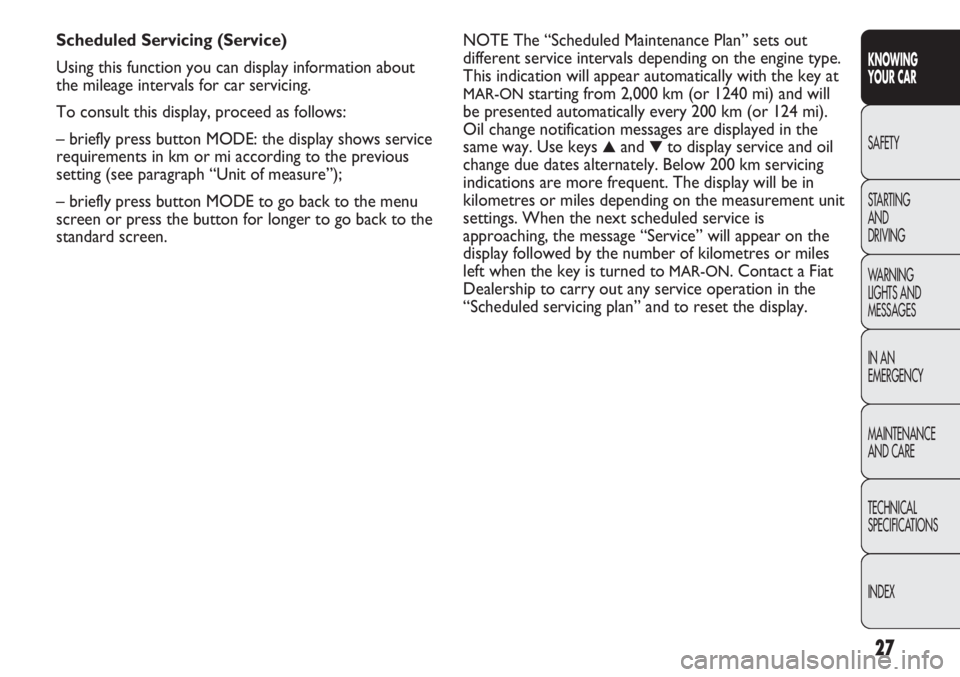
27
KNOWING
YOUR CAR
SAFETY
STARTING
AND
DRIVING
WARNING
LIGHTS AND
MESSAGES
IN AN
EMERGENCY
MAINTENANCE
AND CARE
TECHNICAL
SPECIFICATIONS
INDEX
NOTE The “Scheduled Maintenance Plan” sets out
different service intervals depending on the engine type.
This indication will appear automatically with the key at
MAR-ONstarting from 2,000 km (or 1240 mi) and will
be presented automatically every 200 km (or 124 mi).
Oil change notification messages are displayed in the
same way. Use keys
▲and ▼to display service and oil
change due dates alternately. Below 200 km servicing
indications are more frequent. The display will be in
kilometres or miles depending on the measurement unit
settings. When the next scheduled service is
approaching, the message “Service” will appear on the
display followed by the number of kilometres or miles
left when the key is turned to
MAR-ON. Contact a Fiat
Dealership to carry out any service operation in the
“Scheduled servicing plan” and to reset the display. Scheduled Servicing (Service)
Using this function you can display information about
the mileage intervals for car servicing.
To consult this display, proceed as follows:
– briefly press button MODE: the display shows service
requirements in km or mi according to the previous
setting (see paragraph “Unit of measure”);
– briefly press button MODE to go back to the menu
screen or press the button for longer to go back to the
standard screen.
Page 33 of 287
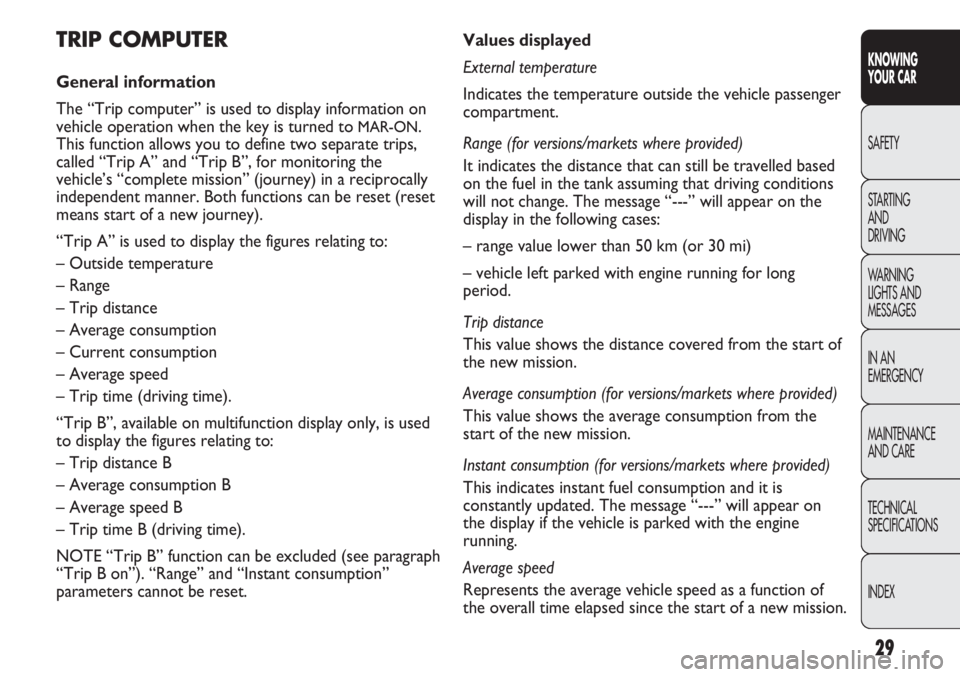
29
KNOWING
YOUR CAR
SAFETY
STARTING
AND
DRIVING
WARNING
LIGHTS AND
MESSAGES
IN AN
EMERGENCY
MAINTENANCE
AND CARE
TECHNICAL
SPECIFICATIONS
INDEX
Values displayed
External temperature
Indicates the temperature outside the vehicle passenger
compartment.
Range (for versions/markets where provided)
It indicates the distance that can still be travelled based
on the fuel in the tank assuming that driving conditions
will not change. The message “---” will appear on the
display in the following cases:
– range value lower than 50 km (or 30 mi)
– vehicle left parked with engine running for long
period.
Trip distance
This value shows the distance covered from the start of
the new mission.
Average consumption (for versions/markets where provided)
This value shows the average consumption from the
start of the new mission.
Instant consumption (for versions/markets where provided)
This indicates instant fuel consumption and it is
constantly updated. The message “---” will appear on
the display if the vehicle is parked with the engine
running.
Average speed
Represents the average vehicle speed as a function of
the overall time elapsed since the start of a new mission.TRIP COMPUTER
General information
The “Trip computer” is used to display information on
vehicle operation when the key is turned to
MAR-ON.
This function allows you to define two separate trips,
called “Trip A” and “Trip B”, for monitoring the
vehicle’s “complete mission” (journey) in a reciprocally
independent manner. Both functions can be reset (reset
means start of a new journey).
“Trip A” is used to display the figures relating to:
– Outside temperature
– Range
– Trip distance
– Average consumption
– Current consumption
– Average speed
– Trip time (driving time).
“Trip B”, available on multifunction display only, is used
to display the figures relating to:
– Trip distance B
– Average consumption B
– Average speed B
– Trip time B (driving time).
NOTE “Trip B” function can be excluded (see paragraph
“Trip B on”). “Range” and “Instant consumption”
parameters cannot be reset.
Page 45 of 287
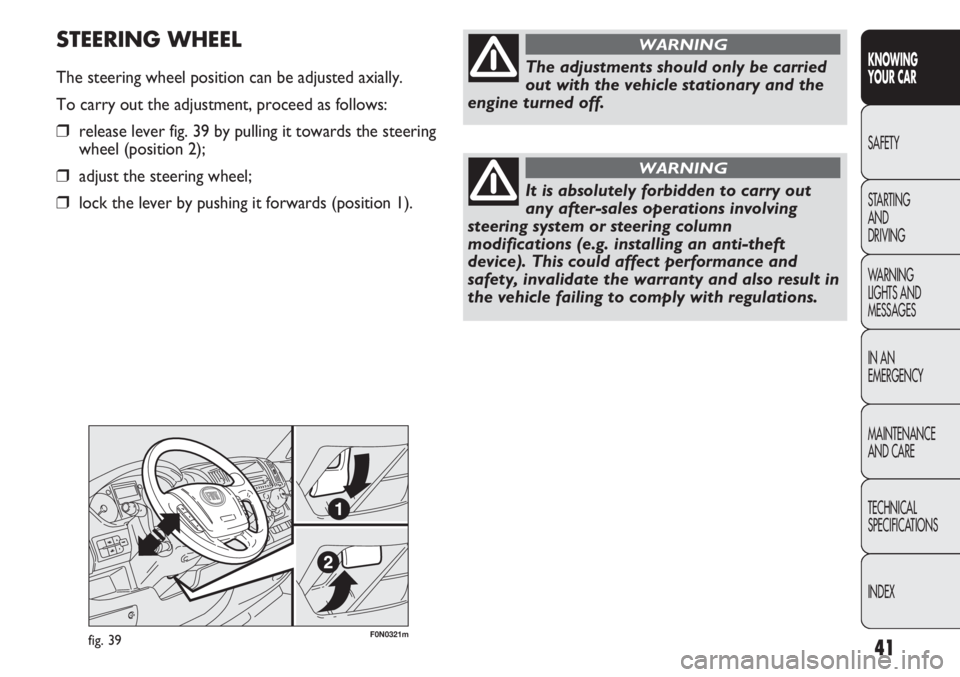
41
KNOWING
YOUR CAR
SAFETY
STARTING
AND
DRIVING
WARNING
LIGHTS AND
MESSAGES
IN AN
EMERGENCY
MAINTENANCE
AND CARE
TECHNICAL
SPECIFICATIONS
INDEX
F0N0321mfig. 39
STEERING WHEEL
The steering wheel position can be adjusted axially.
To carry out the adjustment, proceed as follows:
❒release lever fig. 39 by pulling it towards the steering
wheel (position 2);
❒adjust the steering wheel;
❒lock the lever by pushing it forwards (position 1).
The adjustments should only be carried
out with the vehicle stationary and the
engine turned off.
WARNING
It is absolutely forbidden to carry out
any after-sales operations involving
steering system or steering column
modifications (e.g. installing an anti-theft
device). This could affect performance and
safety, invalidate the warranty and also result in
the vehicle failing to comply with regulations.
WARNING
Page 51 of 287
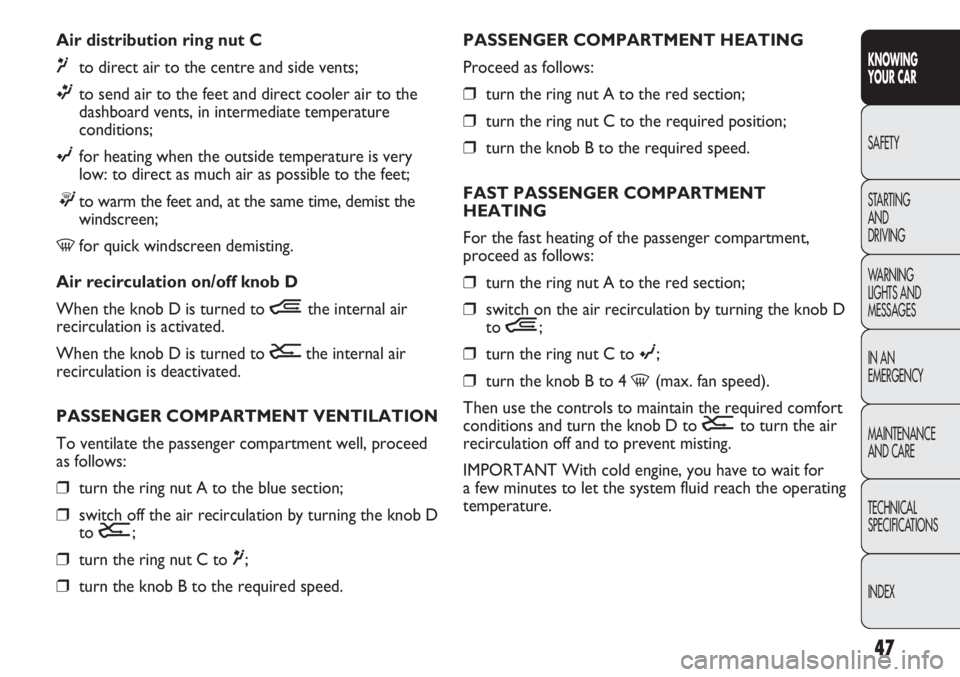
47
KNOWING
YOUR CAR
SAFETY
STARTING
AND
DRIVING
WARNING
LIGHTS AND
MESSAGES
IN AN
EMERGENCY
MAINTENANCE
AND CARE
TECHNICAL
SPECIFICATIONS
INDEX
PASSENGER COMPARTMENT HEATING
Proceed as follows:
❒turn the ring nut A to the red section;
❒turn the ring nut C to the required position;
❒turn the knob B to the required speed.
FAST PASSENGER COMPARTMENT
HEATING
For the fast heating of the passenger compartment,
proceed as follows:
❒turn the ring nut A to the red section;
❒switch on the air recirculation by turning the knob D
to
Ò;
❒turn the ring nut C to ©;
❒turn the knob B to 4-(max. fan speed).
Then use the controls to maintain the required comfort
conditions and turn the knob D to
Úto turn the air
recirculation off and to prevent misting.
IMPORTANT With cold engine, you have to wait for
a few minutes to let the system fluid reach the operating
temperature. Air distribution ring nut C
¶to direct air to the centre and side vents;
ßto send air to the feet and direct cooler air to the
dashboard vents, in intermediate temperature
conditions;
©for heating when the outside temperature is very
low: to direct as much air as possible to the feet;
®to warm the feet and, at the same time, demist the
windscreen;
-for quick windscreen demisting.
Air recirculation on/off knob D
When the knob D is turned to
Òthe internal air
recirculation is activated.
When the knob D is turned to
Úthe internal air
recirculation is deactivated.
PASSENGER COMPARTMENT VENTILATION
To ventilate the passenger compartment well, proceed
as follows:
❒turn the ring nut A to the blue section;
❒switch off the air recirculation by turning the knob D
to
Ú;
❒turn the ring nut C to ¶;
❒turn the knob B to the required speed.
Page 55 of 287
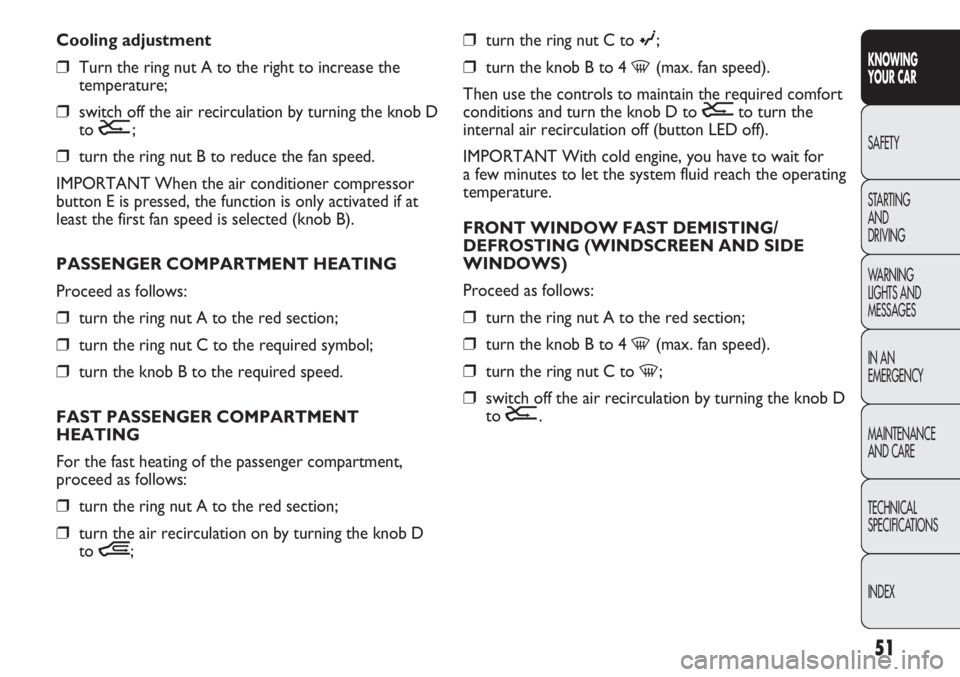
51
KNOWING
YOUR CAR
SAFETY
STARTING
AND
DRIVING
WARNING
LIGHTS AND
MESSAGES
IN AN
EMERGENCY
MAINTENANCE
AND CARE
TECHNICAL
SPECIFICATIONS
INDEX
❒turn the ring nut C to ©;
❒turn the knob B to 4-(max. fan speed).
Then use the controls to maintain the required comfort
conditions and turn the knob D to
Úto turn the
internal air recirculation off (button LED off).
IMPORTANT With cold engine, you have to wait for
a few minutes to let the system fluid reach the operating
temperature.
FRONT WINDOW FAST DEMISTING/
DEFROSTING (WINDSCREEN AND SIDE
WINDOWS)
Proceed as follows:
❒turn the ring nut A to the red section;
❒turn the knob B to 4-(max. fan speed).
❒turn the ring nut C to -;
❒switch off the air recirculation by turning the knob D
to
Ú. Cooling adjustment
❒Turn the ring nut A to the right to increase the
temperature;
❒switch off the air recirculation by turning the knob D
to
Ú;
❒turn the ring nut B to reduce the fan speed.
IMPORTANT When the air conditioner compressor
button E is pressed, the function is only activated if at
least the first fan speed is selected (knob B).
PASSENGER COMPARTMENT HEATING
Proceed as follows:
❒turn the ring nut A to the red section;
❒turn the ring nut C to the required symbol;
❒turn the knob B to the required speed.
FAST PASSENGER COMPARTMENT
HEATING
For the fast heating of the passenger compartment,
proceed as follows:
❒turn the ring nut A to the red section;
❒turn the air recirculation on by turning the knob D
to
Ò;
Page 63 of 287
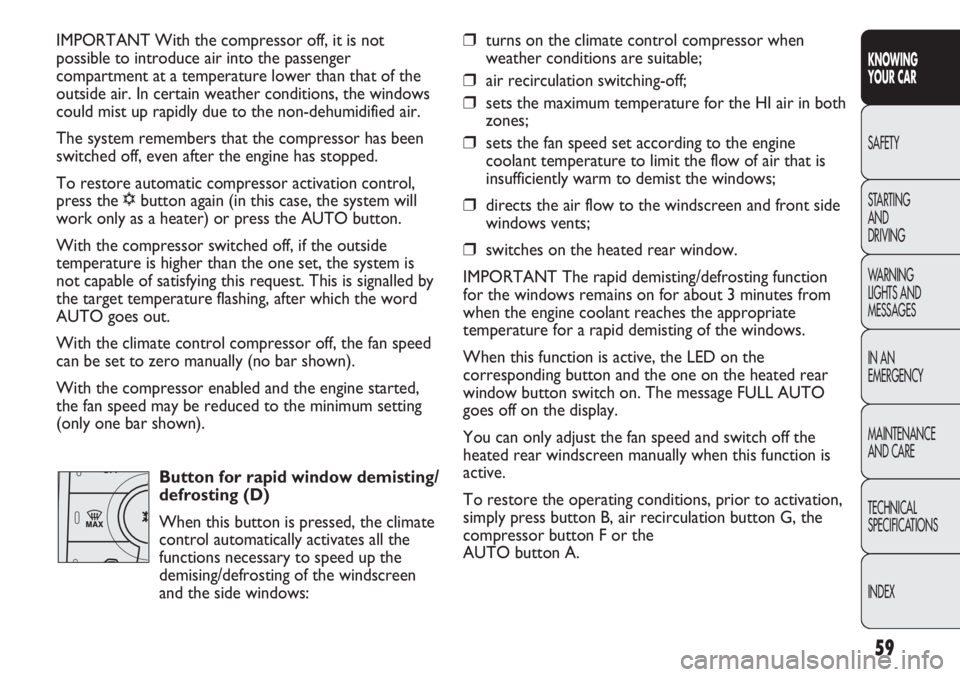
59
KNOWING
YOUR CAR
SAFETY
STARTING
AND
DRIVING
WARNING
LIGHTS AND
MESSAGES
IN AN
EMERGENCY
MAINTENANCE
AND CARE
TECHNICAL
SPECIFICATIONS
INDEX
IMPORTANT With the compressor off, it is not
possible to introduce air into the passenger
compartment at a temperature lower than that of the
outside air. In certain weather conditions, the windows
could mist up rapidly due to the non-dehumidified air.
The system remembers that the compressor has been
switched off, even after the engine has stopped.
To restore automatic compressor activation control,
press the √button again (in this case, the system will
work only as a heater) or press the AUTO button.
With the compressor switched off, if the outside
temperature is higher than the one set, the system is
not capable of satisfying this request. This is signalled by
the target temperature flashing, after which the word
AUTO goes out.
With the climate control compressor off, the fan speed
can be set to zero manually (no bar shown).
With the compressor enabled and the engine started,
the fan speed may be reduced to the minimum setting
(only one bar shown).
Button for rapid window demisting/
defrosting (D)
When this button is pressed, the climate
control automatically activates all the
functions necessary to speed up the
demising/defrosting of the windscreen
and the side windows:❒turns on the climate control compressor when
weather conditions are suitable;
❒air recirculation switching-off;
❒sets the maximum temperature for the HI air in both
zones;
❒sets the fan speed set according to the engine
coolant temperature to limit the flow of air that is
insufficiently warm to demist the windows;
❒directs the air flow to the windscreen and front side
windows vents;
❒switches on the heated rear window.
IMPORTANT The rapid demisting/defrosting function
for the windows remains on for about 3 minutes from
when the engine coolant reaches the appropriate
temperature for a rapid demisting of the windows.
When this function is active, the LED on the
corresponding button and the one on the heated rear
window button switch on. The message FULL AUTO
goes off on the display.
You can only adjust the fan speed and switch off the
heated rear windscreen manually when this function is
active.
To restore the operating conditions, prior to activation,
simply press button B, air recirculation button G, the
compressor button F or the
AUTO button A.
Page 65 of 287
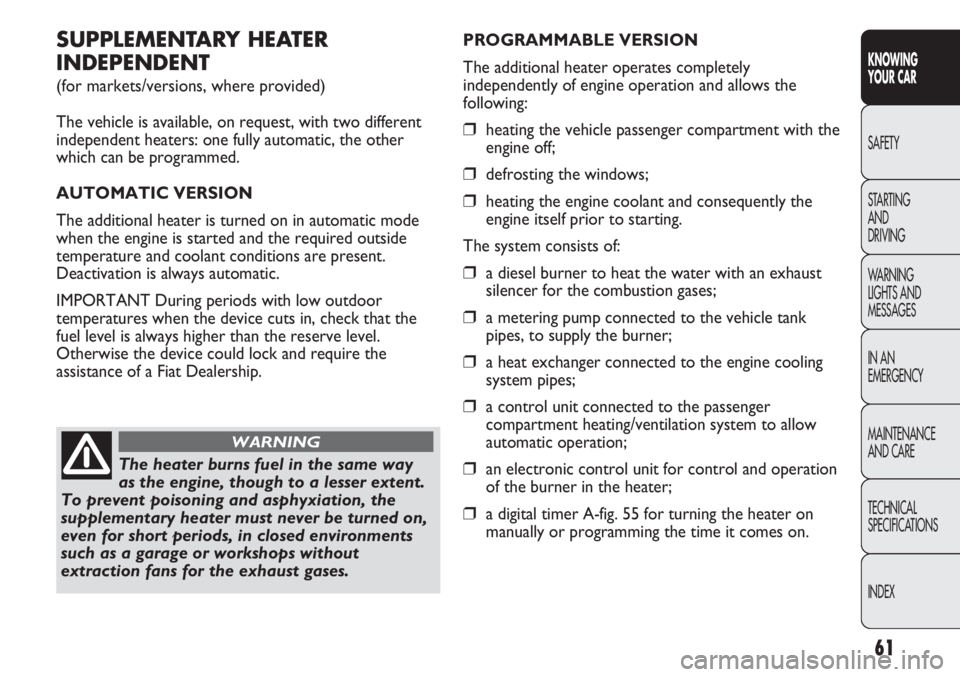
61
KNOWING
YOUR CAR
SAFETY
STARTING
AND
DRIVING
WARNING
LIGHTS AND
MESSAGES
IN AN
EMERGENCY
MAINTENANCE
AND CARE
TECHNICAL
SPECIFICATIONS
INDEX
SUPPLEMENTARY HEATER
INDEPENDENT
(for markets/versions, where provided)
The vehicle is available, on request, with two different
independent heaters: one fully automatic, the other
which can be programmed.
AUTOMATIC VERSION
The additional heater is turned on in automatic mode
when the engine is started and the required outside
temperature and coolant conditions are present.
Deactivation is always automatic.
IMPORTANT During periods with low outdoor
temperatures when the device cuts in, check that the
fuel level is always higher than the reserve level.
Otherwise the device could lock and require the
assistance of a Fiat Dealership.
The heater burns fuel in the same way
as the engine, though to a lesser extent.
To prevent poisoning and asphyxiation, the
supplementary heater must never be turned on,
even for short periods, in closed environments
such as a garage or workshops without
extraction fans for the exhaust gases.
WARNING
PROGRAMMABLE VERSION
The additional heater operates completely
independently of engine operation and allows the
following:
❒heating the vehicle passenger compartment with the
engine off;
❒defrosting the windows;
❒heating the engine coolant and consequently the
engine itself prior to starting.
The system consists of:
❒a diesel burner to heat the water with an exhaust
silencer for the combustion gases;
❒a metering pump connected to the vehicle tank
pipes, to supply the burner;
❒a heat exchanger connected to the engine cooling
system pipes;
❒a control unit connected to the passenger
compartment heating/ventilation system to allow
automatic operation;
❒an electronic control unit for control and operation
of the burner in the heater;
❒a digital timer A-fig. 55 for turning the heater on
manually or programming the time it comes on.
Page 66 of 287
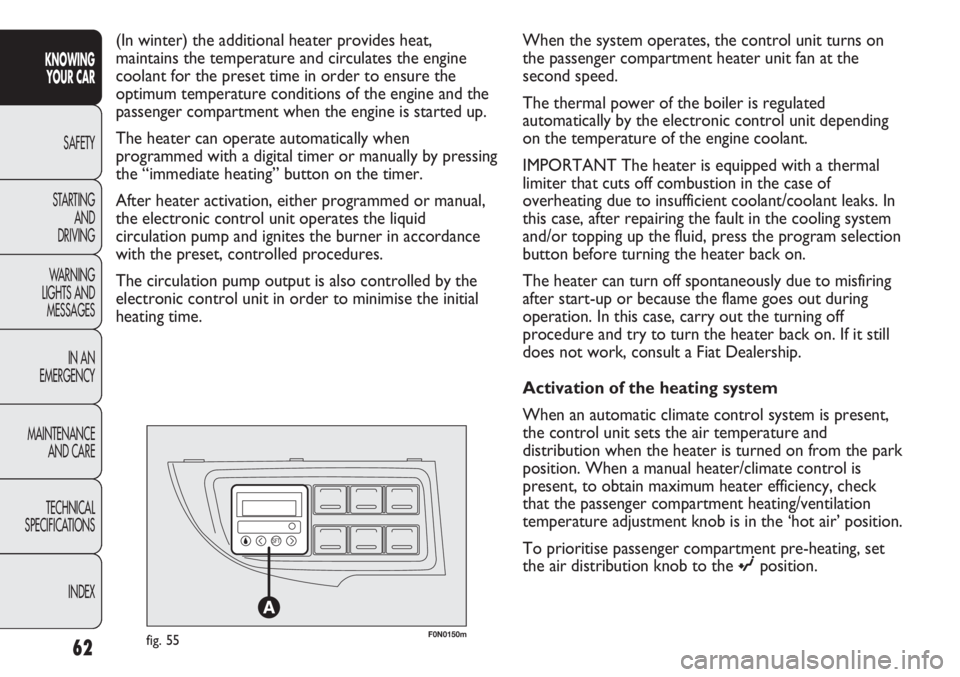
62
KNOWING
YOUR CAR
SAFETY
STARTING
AND
DRIVING
WARNING
LIGHTS AND
MESSAGES
IN AN
EMERGENCY
MAINTENANCE
AND CARE
TECHNICAL
SPECIFICATIONS
INDEX
F0N0150mfig. 55
(In winter) the additional heater provides heat,
maintains the temperature and circulates the engine
coolant for the preset time in order to ensure the
optimum temperature conditions of the engine and the
passenger compartment when the engine is started up.
The heater can operate automatically when
programmed with a digital timer or manually by pressing
the “immediate heating” button on the timer.
After heater activation, either programmed or manual,
the electronic control unit operates the liquid
circulation pump and ignites the burner in accordance
with the preset, controlled procedures.
The circulation pump output is also controlled by the
electronic control unit in order to minimise the initial
heating time. When the system operates, the control unit turns on
the passenger compartment heater unit fan at the
second speed.
The thermal power of the boiler is regulated
automatically by the electronic control unit depending
on the temperature of the engine coolant.
IMPORTANT The heater is equipped with a thermal
limiter that cuts off combustion in the case of
overheating due to insufficient coolant/coolant leaks. In
this case, after repairing the fault in the cooling system
and/or topping up the fluid, press the program selection
button before turning the heater back on.
The heater can turn off spontaneously due to misfiring
after start-up or because the flame goes out during
operation. In this case, carry out the turning off
procedure and try to turn the heater back on. If it still
does not work, consult a Fiat Dealership.
Activation of the heating system
When an automatic climate control system is present,
the control unit sets the air temperature and
distribution when the heater is turned on from the park
position. When a manual heater/climate control is
present, to obtain maximum heater efficiency, check
that the passenger compartment heating/ventilation
temperature adjustment knob is in the ‘hot air’ position.
To prioritise passenger compartment pre-heating, set
the air distribution knob to the
©position.
Page 69 of 287
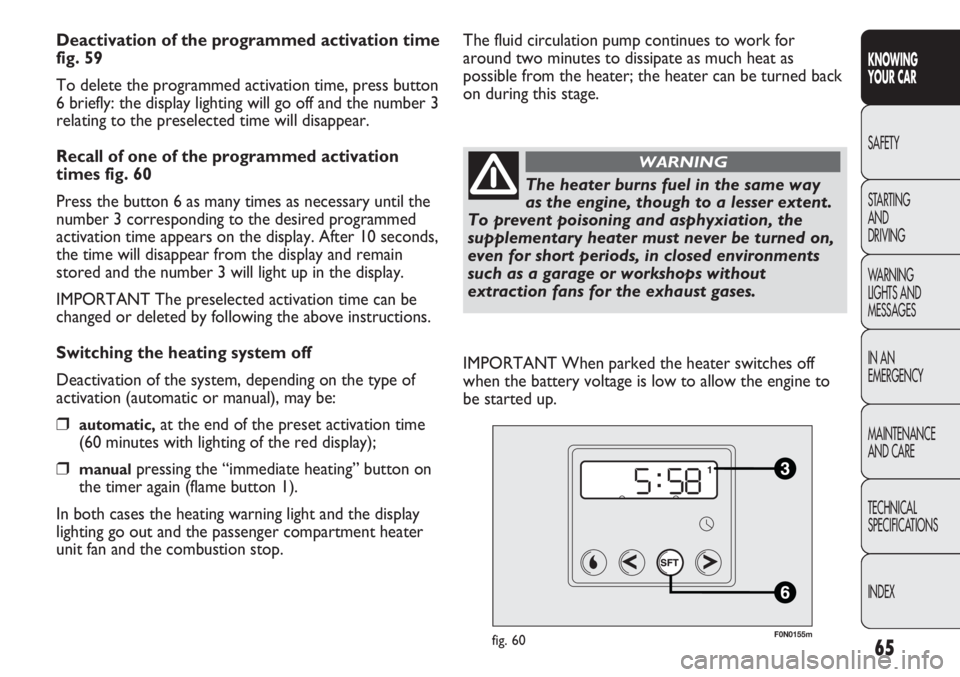
65
KNOWING
YOUR CAR
SAFETY
STARTING
AND
DRIVING
WARNING
LIGHTS AND
MESSAGES
IN AN
EMERGENCY
MAINTENANCE
AND CARE
TECHNICAL
SPECIFICATIONS
INDEX
Deactivation of the programmed activation time
fig. 59
To delete the programmed activation time, press button
6 briefly: the display lighting will go off and the number 3
relating to the preselected time will disappear.
Recall of one of the programmed activation
times fig. 60
Press the button 6 as many times as necessary until the
number 3 corresponding to the desired programmed
activation time appears on the display. After 10 seconds,
the time will disappear from the display and remain
stored and the number 3 will light up in the display.
IMPORTANT The preselected activation time can be
changed or deleted by following the above instructions.
Switching the heating system off
Deactivation of the system, depending on the type of
activation (automatic or manual), may be:
❒automatic,at the end of the preset activation time
(60 minutes with lighting of the red display);
❒manualpressing the “immediate heating” button on
the timer again (flame button 1).
In both cases the heating warning light and the display
lighting go out and the passenger compartment heater
unit fan and the combustion stop.
F0N0155mfig. 60
The fluid circulation pump continues to work for
around two minutes to dissipate as much heat as
possible from the heater; the heater can be turned back
on during this stage.
The heater burns fuel in the same way
as the engine, though to a lesser extent.
To prevent poisoning and asphyxiation, the
supplementary heater must never be turned on,
even for short periods, in closed environments
such as a garage or workshops without
extraction fans for the exhaust gases.
WARNING
IMPORTANT When parked the heater switches off
when the battery voltage is low to allow the engine to
be started up.
Page 70 of 287
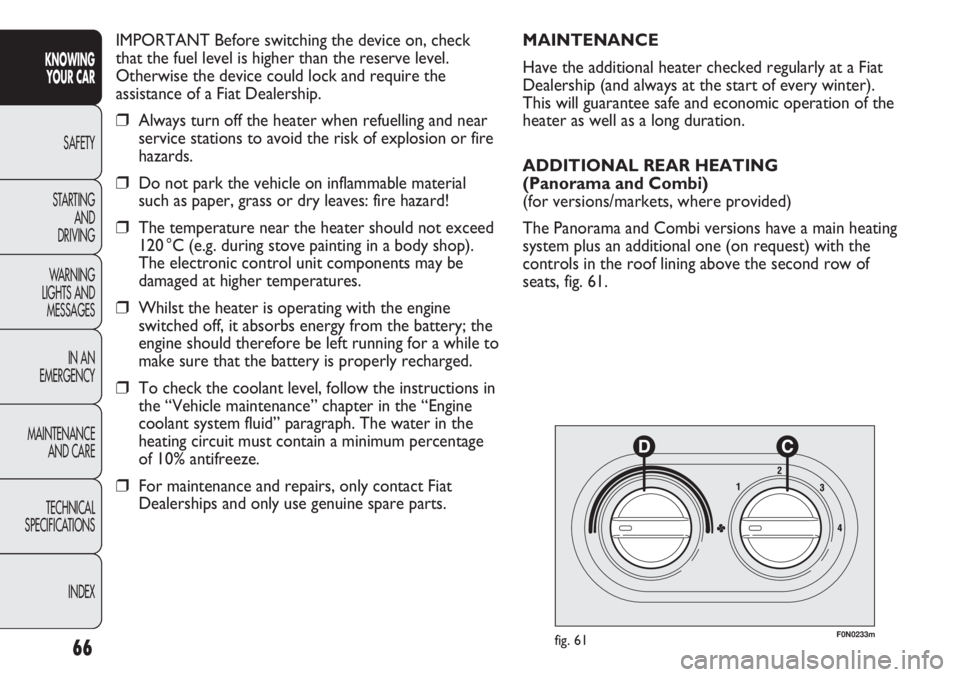
66
KNOWING
YOUR CAR
SAFETY
STARTING
AND
DRIVING
WARNING
LIGHTS AND
MESSAGES
IN AN
EMERGENCY
MAINTENANCE
AND CARE
TECHNICAL
SPECIFICATIONS
INDEX
IMPORTANT Before switching the device on, check
that the fuel level is higher than the reserve level.
Otherwise the device could lock and require the
assistance of a Fiat Dealership.
❒Always turn off the heater when refuelling and near
service stations to avoid the risk of explosion or fire
hazards.
❒Do not park the vehicle on inflammable material
such as paper, grass or dry leaves: fire hazard!
❒The temperature near the heater should not exceed
120 °C (e.g. during stove painting in a body shop).
The electronic control unit components may be
damaged at higher temperatures.
❒Whilst the heater is operating with the engine
switched off, it absorbs energy from the battery; the
engine should therefore be left running for a while to
make sure that the battery is properly recharged.
❒To check the coolant level, follow the instructions in
the “Vehicle maintenance” chapter in the “Engine
coolant system fluid” paragraph. The water in the
heating circuit must contain a minimum percentage
of 10% antifreeze.
❒For maintenance and repairs, only contact Fiat
Dealerships and only use genuine spare parts.
F0N0233mfig. 61
MAINTENANCE
Have the additional heater checked regularly at a Fiat
Dealership (and always at the start of every winter).
This will guarantee safe and economic operation of the
heater as well as a long duration.
ADDITIONAL REAR HEATING
(Panorama and Combi)
(for versions/markets, where provided)
The Panorama and Combi versions have a main heating
system plus an additional one (on request) with the
controls in the roof lining above the second row of
seats, fig. 61.